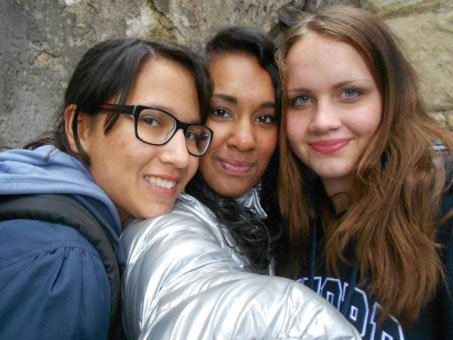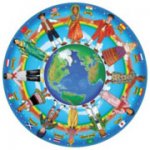International Peace Day in the Netherlands
UNLIKELY FRIENDSHIPS
Each year the International Day of Peace is observed around the world on 21 September. The General Assembly has declared this as a day devoted to strengthening the ideals of peace, both within and among all nations and peoples. The Preamble to the United Nations Charter states that the Organization was founded to prevent and resolve international conflicts and help build a culture of peace in the world. Peace and democracy are inextricably linked. Together, they form a partnership that promotes the well-being of all. Embodied in the Universal Declaration of Human Rights, democracy supports an environment for a host of political rights and civil liberties. In line with the Day’s theme, something profoundly remarkable is happening in the world. Young women and men everywhere are demonstrating the power of solidarity by reaching out and rallying together for the common goal of dignity and human rights. This powerful force brings with it the potential to create a peaceful and democratic future. Add your voice!
There are many ways to participate in democratic practices, including taking part in dialogue on constitutional processes, advocating for civil society empowerment, joining the struggle for gender equality and against discrimination, engaging in civic education and promoting voter registration.
As Coordinators and chapters leaders of Children of the Earth, The International Day of Peace offers us globally, a shared date to organize events and undertake deeds celebrating the importance of peace and democracy in realistic and useful ways. This seemed like an amazing and wonderful challenge to me when I first heard about the chance to make a contribution to International Day of Peace. While we are just starting up with Children of the Earth in the Netherlands I gave it some clear thought on how to contribute to a sustainable peace in the Netherlands while making a small effort that could also be the start of Children of the Earth Netherlands. Currently, in our country we are facing issues with the discrimination of minority groups in the Netherlands. It seems as if in our country that was once known to be tolerant there are some people that seem to be blaming everyone with a different religion, color of skin, cultural background or nationality. Hopefully this small contribution from me personally but also three girls I just met will help us to again show us the beauty of the diversity of life, as well as the value of recognizing the difference in each other that can unite but also tear us apart sometimes. It starts with the idea of learning from each other’s uniqueness, trying not to harm, being tolerant and respectful from where there’s a basis for friendship. Hope this inside view in the life of three teenagers shows that peace doesn’t need a quite quiet place but can be right there in the middle of the crowdedness of daily life. Peace needs our heart to stay calm within this busy world we live in. And this is where I found three Dutch girls from the third grade of the Wolfert van Borselen Tweetalig (bilingual college) in Rotterdam, The Netherlands. The school offers high quality education within an international environment for children that are active and curious by nature and have the ambition to develop this further during their future professional lives. For example next to English, French and German they have Chinese and Spanish within their curriculum as well. Even though they have very busy schedules that start at twenty past eight in the morning till four in the afternoon where after they need to do loads and loads of homework they found some time to do a service learning project in which they speak with me about friendship, tolerance and their various cultural backgrounds.
Please let me introduce you this year with the International Peace Day of the United Nations to the three girls Sadhana (14), Asya (15) and Aslı (14). Sadhana is both Hindu and Surinam at the same time. Her mom is half Surinam and half Hindu. Her dad is full Hindu. She believes in Hinduism and that’s why she doesn’t eat beef. Sadhana likes shopping, playing tennis and girly things like putting on make-up and wearing jewelry. Asya is of TurkishTurkish origin. Her mom and dad are both Turkish. She’s a Muslim and that’s why she doesn’t eat pork though she is not going to the mosque and she doesn’t wear a head kerchief, so she is not extremely religious. She participates in the Ramadan, though. Asya likes to play basketball, skating and boyish stuff like teasing the other two girls. Aslı is half Turkish and half Dutch from origin. Her mom is from Turkey and her dad is from Holland. She feels primarily Dutch, does not eat pork and does sometimes participate in the Ramadan. She is also celebrating Christmas and Easter. Aslı likes horse riding, karate and spending time with family and friends. Actually, she is not religious. Secretly, I was wondering what friendship means for these girls and how they would describe their friendships.
So, what’s friendship? I asked. According to Asya it means that you are doing crazy stuff together and that you can hang out as long as you and whatever you are doing, you can always count on your friends. Also Aslı thinks friendship is about fun stuff and that your friends are always there for you no matter whatever stupid thing you and that they can laugh with you. Sadhana believes friends is about being there for each other, protecting each other in difficult times and do things for each other for which you don’t immediately want something in return. When I asked them why they are friends and what makes their friendship special and important the girls came up with different reasons: Aslı thought Asya and Sadhana are very nice and crazy girls while they always come up with the craziest ideas to which she can’t say no as they are so funny. They also speak a bit of each other’s language and that makes their friendship extra special. Asya also thinks her friends are funny and she loves doing crazy and funny things together, as well. They are all from different cultures and that makes their relations special while you don’t see this that often. Asya says that besides they are having a lot of fun together the other two are very sweet girls and they really understand each other while they have a special “click”. Because of that “click” they often think the same. It seems like for these young girls it is the case that even though they are from very different cultural backgrounds they still speak the very same language. These are such wonderful girls, I thought.
Nevertheless I was wondering how they would experience each other’s cultures. The subsequent question I posed was therefore: What do you like about each other´s cultures? Sadhana answered that she thinks the food in Turkey is really nice and it´s real fun to hear Aslı speak Turkish, because when she does she mostly uses very bad words! Aslı, on the other hand, likes the Hindi and Surinam cultural background of Sadhana very much while at her house they are always friendly and hospitable. This is the same with Asya´s where they are Muslim at home. Because Aslı is not fully a Muslim she always learns new things about her own culture from Asya. So they have many things to talk about! Asya thinks it´s funny that the Hindu and Muslim culture are so similar while for example when celebrating a wedding they also do this for three days, just like within the Islamic culture. Next to that she really likes the Surinam food of her other friend Sadhana. Also the girls thought that because of their different cultural backgrounds it´s sometimes real nice to make fun of each other!
Aren´t you sometimes also a bit unfriendly with each other? I asked them. This because I could almost not believe the girls are always getting along that well while spending so much time with each other. Sadhana is stressed out very quickly about small things and Aslı sometimes talks through my story, Asya said. Asya talks very much so I often don´t get her, actually most of the times, Aslı responds. Sadhana is really stressed, she continued. Aslı really talks too much about the same things sometimes, Sadhana came up with.
Before creating more tensions between the young girls I decided to leave the subject and go further with the following question. What is it actually they have really learned from each other? And what do they learn from each other´s cultural backgrounds? Aslı learned from Sadhana that you can have fun even though you are busy with school. You just need to make a bit more time for each other and then it can even be fun to learn and study. From Asya she learned that she needs to respect people and talk positive about them. Also she learned that Hinduism is not that bad and that being a Muslim doesn´t necessary mean that you are being strict all the time. Also she learned a lot about Hinduism from Sadhana and that it´s really much more than just not eating beef. From Aslı she learned that you don´t have to chose between being a Muslim and a Christian and that you have the freedom to be whoever you want to be. Sadhana, on the other hand, has learned from Aslı that Turkish people are much more than just people that wear a head kerchief. She also learned from Aslı that everything in the world is possible. You just need to want it very badly and make an effort to achieve it. From Asya she learned how to be open to all kind of people without judging them on beforehand. I thought these were lovely, kind and mostly very wise girls. Even though they are very young, they seemed to understand the deepest secrets of life about which some other people would never learn. Hopefully they will keep this treasure within their hearts for the rest of their lives! And even better, perhaps they would teach others how to do the same.









